Compact fibre Bragg grating-based thermometer for on-line temperature monitoring of drill bits
Project type: Semester of Master project (new)
Goal: Implementation of a novel compact optical fibre-based thermometer for on-line temperature monitoring of a rotating drill bit.
Description: Drilling is nowadays a widely used operation, whether it is to make holes of various sizes and depths for the manufacturing of mechanical and electrical components or for modern surgery procedures to drill bones in orthopedics/traumatology and dentistry. During the drilling process, most of the mechanical energy is converted into frictional heat. This temperature rise may result in damages such as rapid tool wear and diametrical errors in hole size during mechanical processes, drill smear, which affects the reliability of printed circuit boards (PCBs), or irreversible osteonecrosis during bone drilling.
To reduce these aforementioned risks due to over-heating, thermocouples, we propose to use a fibre Bragg gratings (FBG) for temperature monitoring of drill bits instead of the commonly used devices such as infra-red (IR) thermometer, IR camera and thermocouple.
Indeed, FBGs are simple, miniature (a few mms long and 1/10 of mm in diameter) sensing elements encompassing all the advantages attributed to optical fibres (electrically insulating, chemically inert, etc.) and are sensitive to temperature change, which make them very good candidates for temperature monitoring of small drill bits.
We are currently developing a new interrogation system for measuring the temperature of a rotating drill bit interface. The student will be asked to contribute on the development of this system. Other interesting aspects will also be treated, such as temperature flow inertia and optical light coupling inside the drill bit.
Required knowledge: Basic knowledge in optical fibre and in Labview programming
Supervisors: Prof. Luc Thévenaz, Dr. Kenny Hey Tow
Nonlinear pulse propagation in optical fibers (past project)
In this project the impact of different nonlinear phenomena on optical pulses propagating in an optical fiber is investigated. The interaction between the linear effect, i.e. dispersion and loss, and various types of nonlinearity will be examined thoroughly. For some simple cases like self-phase modulation (SPM), the analytical solution exists. However, there are plenty of interesting conditions that cannot be represented in a closed-form solution. Accordingly, the use of numerical methods to simulate the real conditions of pulse propagation seems indispensable. Among a bunch of methodologies, the split-step Fourier method for solving the nonlinear Schrödinger equation (NLSE) has been massively utilized due to its unique advantages. During this project, besides the linear phenomena of attenuation and dispersion, the following nonlinear effects will be taken into account:
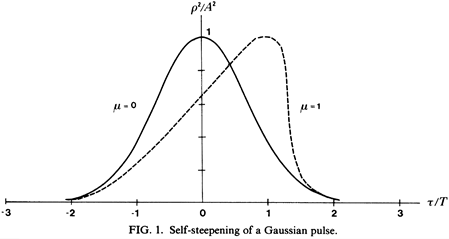
1. Kerr effect
2. Self-steepening
3. Intra-pulse Raman scattering
The behavior of optical pulses under the impact of each phenomenon is considered individually and the whole interaction together will be investigated too. Different types of optical pulses such as Gaussian, rectangular, hyperbolic secant, Breather and Peregrine solitons will be examined as the initial pulse launched into the fiber. Moreover, the evolution of pulse spectrum during the propagation will be scrutinized in order to shed light on how a supercontinuum is generated in an optical fiber. Various kinds of fiber with different dispersion profile including standard single-mode fiber (SMF), dispersion-shifted fiber (DSF), and nonzero dispersion-shifted fiber (NZ-DSF) with positive and negative dispersion must be considered. The output of this project will be:
1. A report on the theoretical aspects of above-mentioned phenomena.
2. A package of MTLAB codes and simulations implementing the nonlinear effects.
It must be mentioned that in this project, we neglect the effect of light polarization for simplicity; something that can be the subject of another project coming after the current one. Please notice that although this project has no experimental part, it can be an appropriate benchmark for any advanced experiment of ultra-short pulse propagation in optical fibers.
Required knowledge:
Basics in wave propagation, numerical analysis and MATLAB programming.
Knowledge of fiber optics and differential equations will be helpful.
Supervisor: Prof. Luc Thévenaz
Assistant: Mehdi Alem
____________________________________________________________________________________________
Compact temperature sensor based on Fiber Bragg Gratings (past project)
Project type: Semester or Master project
Goal : Implementation of a simple and compact fibre-based optical sensor with a targeted temperature sensitivity of 0.1°C.
Description: Fibre Bragg Gratings (FBGs) are simple, intrinsic sensing elements which can be photo-inscribed into an optical fibre making them potentially very miniature (a few mms long) and giving them all the advantages attributed to fibre sensors (electrically insulating, chemically inert). Moreover, they can be serially-multiplexed along a single lead fibre. All these properties make them ideal sensors for “smart structures” in which fibre optic sensors are embedded in (or attached to) a material for monitoring temperature.
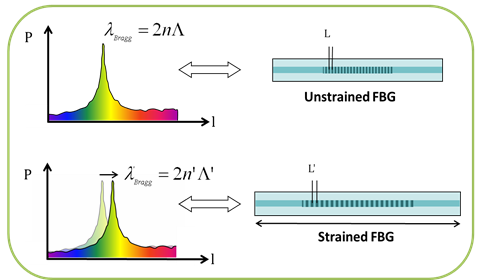
Working principle of a FBG sensor
A FBG is characterised by its Bragg resonance, which is fixed by the optical pitch of the periodic perturbation of the refractive index. Any change in the refractive index by temperature, or in the physical elongation due to thermal expansion will modify the Bragg resonance. The basic principle of operation commonly used in a FBG-based sensor system is to monitor the reflected or transmitted light from the Bragg grating to detect a wavelength shift of its resonance induced by the measurand.
The main drawback linked to the use of a FBG as a sensor is its sensitivity to other parameters such as strain or vibrations. During the measuring process, there is always the risk that the FBG is axially stretched. The combination of the strain with a change in temperature may lead to anomalous and incorrect measurements. There are several approaches that can be adopted to discriminate strain to temperature measurements in FBGs. The goal here is to design an efficient way to discriminate an axial strain to temperature change in the sensing system for the targeted sensitivity of 0.1 °C
Supervisor: Prof. Luc Thévenaz
Assistant: Dr. Kenny Hey Tow
____________________________________________________________________________________________
Self-phase modulation in optical fibers (past project)
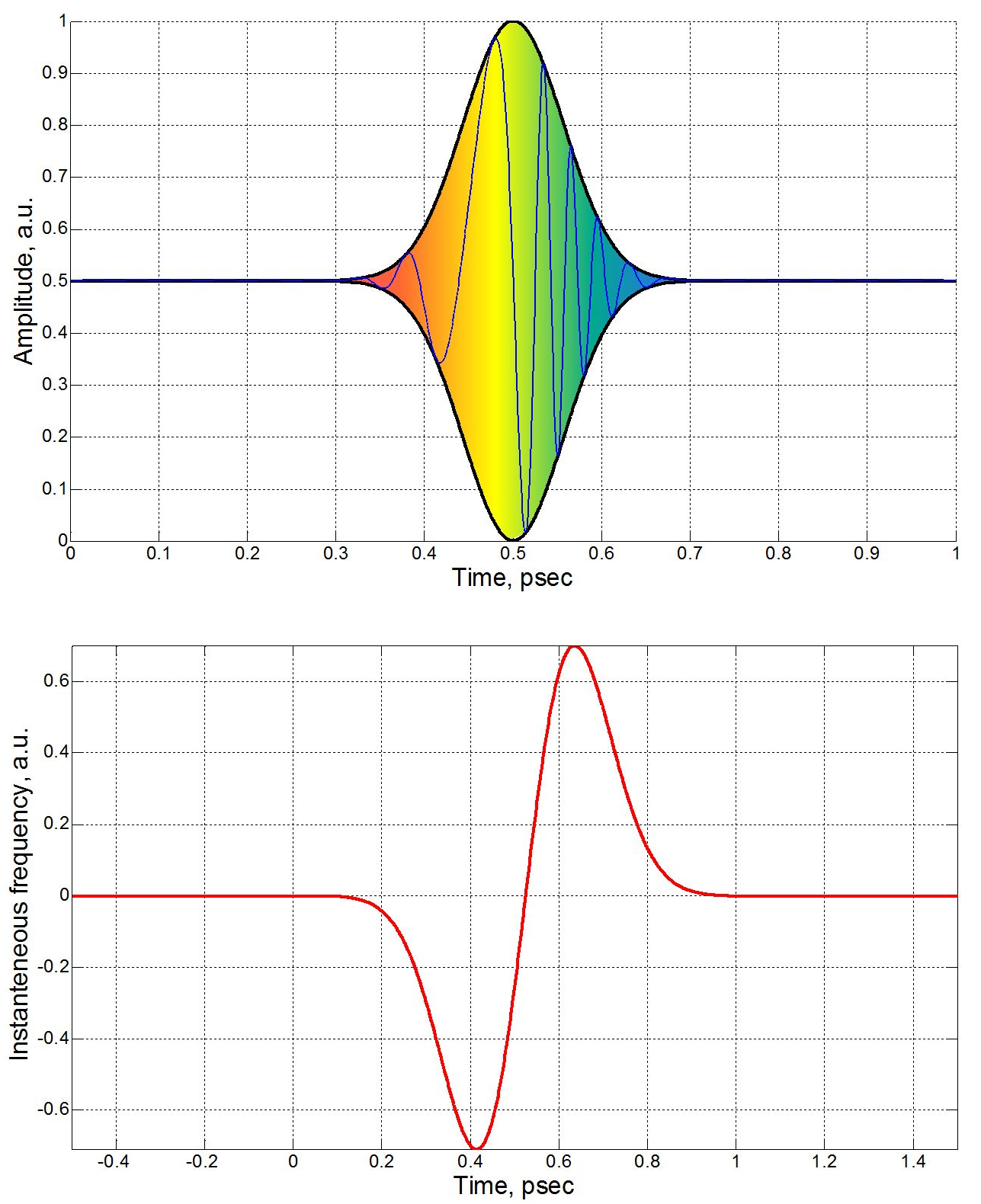 Various nonlinear effects in optical fibers are constantly investigated and applied in different fields ranging from structural health monitoring and sensing to innovative optical signal processing of telecommunication and radio frequency signals. Self-phase modulation (SPM) is one of the prominent effects which is observed in silica fibers and has led to the realization of advanced functions, particularly the possibility to control a light signal by another light signal. For the last several years SPM has been used for pulse compression, dispersion compensation, supercontinuum generation, wavelength conversion and optical switching. In this project we propose to a student to experimentally observe the effect of SPM and conduct several experiments to describe conditions and properties of SPM in optical fibers.
Various nonlinear effects in optical fibers are constantly investigated and applied in different fields ranging from structural health monitoring and sensing to innovative optical signal processing of telecommunication and radio frequency signals. Self-phase modulation (SPM) is one of the prominent effects which is observed in silica fibers and has led to the realization of advanced functions, particularly the possibility to control a light signal by another light signal. For the last several years SPM has been used for pulse compression, dispersion compensation, supercontinuum generation, wavelength conversion and optical switching. In this project we propose to a student to experimentally observe the effect of SPM and conduct several experiments to describe conditions and properties of SPM in optical fibers.
The aim of this master project is to build a setup to observe the effect of SPM in optical fibers, study and investigate optical power thresholds, dependence of fiber length and fiber type on SPM efficiency. The student will learn the theory of self-phase modulation, build an experimental setup and perform characterization of SPM in various fibers. This work is mainly lab-oriented and is carried out in the three main parts as follows:
Theory
In the theoretical part, the mathematical background for self-phase modulation is thoroughly studied. This study includes the propagation of optical pulses through optical fibers, the Kerr nonlinear effect, nonlinear Schrödinger equation (NLSE), self-phase modulation, spectral broadening and frequency chirp.
Simulation
To verify any analytical models or experimental measurements it is needed to obtain exact solutions using numerical methods and computer simulations. During this part, the effect of SPM is investigated via simulating the NLSE using split-step Fourier method.
Experiment
A couple of experiments will be run to observe the effect of SPM on optical pulses and to measure the induced phase. The spectral broadening due to SPM will be observed. The setup will be used to measure the nonlinear coefficient of several different fibers.
Required knowledge:
Basics in fibre optics, wave propagation, and MATLAB programming are necessary.
Knowledge of numerical analysis will be helpful, but not required.
Supervision: Prof. Luc Thévenaz
Assistant: Mehdi Alem
Characterization of optical components used in fiber-optic systems (past project)
Typically, advanced fiber-optic systems make use of a large number of optical components to fulfill specific objectives. In particular, when an optical fiber system (such as a telecommunication system) is designed, the optimum optical sources, modulators, optical amplifiers, couplers, wavelength-division multiplexers (WDM), photodiodes, and optical fiber, among others, should be properly chosen for the best performance of the implemented system. For this reason, it is crucial that researchers and engineers know all the characteristics of the available optical components so that they could make the best decision when implementing a system.
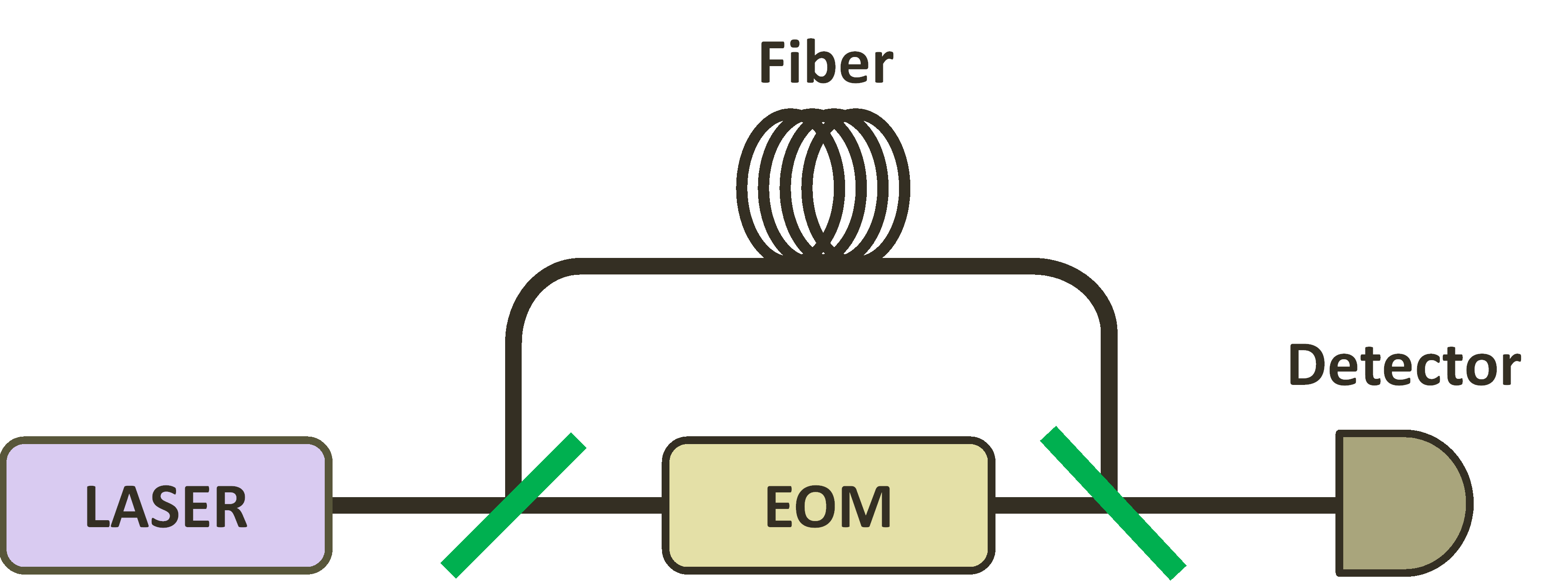 In this project the student will learn how to properly characterize passive and active optical components in an optical fiber system. As for instance, he/she will need to analyze several methods for the characterization of different type of lasers (using for instance optical heterodyne detection schemes, as in the figure), to measure the time- and frequency-domain characteristics of optical amplifiers (parameters such as gain, saturation power, ASE noise have to be measured). In addition, the characterization of other optical components such as electro-optics modulators, optical filters and fiber Bragg gratings, as well as the spectral analysis of modulated optical signals will be also part of this project. The work will be mainly experimental.
In this project the student will learn how to properly characterize passive and active optical components in an optical fiber system. As for instance, he/she will need to analyze several methods for the characterization of different type of lasers (using for instance optical heterodyne detection schemes, as in the figure), to measure the time- and frequency-domain characteristics of optical amplifiers (parameters such as gain, saturation power, ASE noise have to be measured). In addition, the characterization of other optical components such as electro-optics modulators, optical filters and fiber Bragg gratings, as well as the spectral analysis of modulated optical signals will be also part of this project. The work will be mainly experimental.
Required knowledge: Basic knowledge in fiber optics.
Supervision: Prof. Luc Thévenaz
Assistant: Dr. Marcelo Soto
Measurement of chromatic dispersion in optical fibers (past project)
The chromatic dispersion of an optical medium is the phenomenon in which the phase velocity and group velocity of light propagating in a transparent medium depend on the optical frequency. Dispersion in optical fibers comes from two sources: the material dispersion of fused silica and the waveguide dispersion determined by the fiber design. Standard fibers have anomalous dispersion around 1.55 micron wavelength (i.e. group velocity increases with increasing optical frequency), but specially designed fibers can have normal or zero dispersion in that spectral region. Dispersive properties of the fiber are very important for example in telecom applications where multiple spectral channels are used for data transfer.

Pulses of light with higher frequencies propagate faster in fiber
During this project the student will get the understanding of waveguide dispersion and how it can be used to create fibers with desired dispersive properties. Student will build a setup to measure chromatic dispersion in fibers and conduct experiments employing fibers with different type of dispersion.
Required knowledge: Basic knowledge in electromagnetics.
Supervision: Prof. Luc Thévenaz
Assistant: Andrey Denisov
Relative frequency stabilization of two semiconductor lasers, using injection locking technique (past project)
Recently, a promising technique has been developed based on Brillouin Dynamic Gratings (BDG) in polarization maintaining fibers (PMF), which can be useful tool in the fields of fiber optic sensors and microwave photonics. For specific applications in phased array antennas and microwave filters method based on BDG may exceed performance of any other existing techniques. However, for highly efficient generation of Brillouin dynamic gratings inside a PM fiber it is necessary to stabilize in frequency two distinct laser sources with a frequency difference in the order of several tenths of GHz (≈40-45 GHz). The concept of injection locking is known to be used to improve the coherence and reduce the frequency chirp of a semiconductor laser, as well as for generation of high purity millimeter waves. By implementing of injection locking system to generate Brillouin Dynamic Gratings, we would like to improve stability and efficiency of the BDG system.
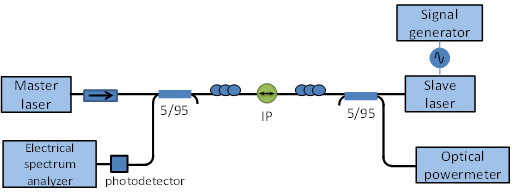
Principle scheme to realize injection locking
This project will be focused on building up a system to stabilize relative frequency between two semiconductor lasers by modulation sideband injection locking principle. This work will be fully completed in the laboratory, using fiber optic components.
Required knowledge: Fundamentals in optics.
Supervision: Prof. Luc Thévenaz
Assistant: Nikolay Primerov